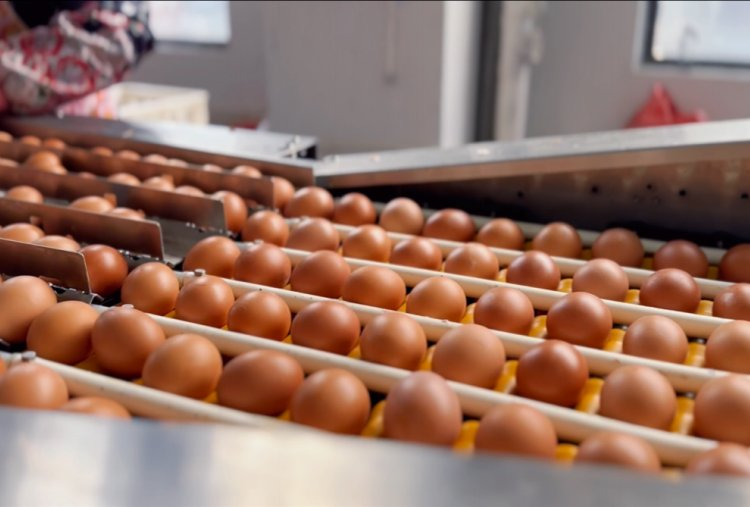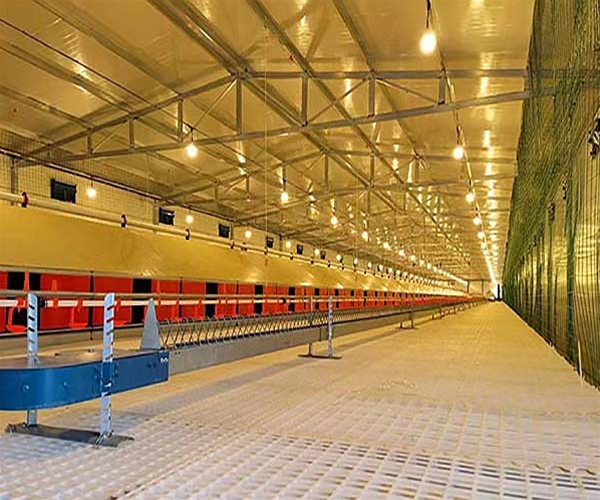With the development of modern poultry farming, egg production facilities increasingly rely on automation. This improves efficiency, reduces labor intensity, and ensures egg quality. As a result, traditional manual methods of collecting, sorting, and cleaning eggs are gradually being replaced by automated systems. These systems process eggs more efficiently and accurately. Today, we will walk you through how eggs go from production to marketable products. In particular, we will highlight how automation through egg conveyors, egg collection machines, centralized egg collection systems, and egg packing machines ensures high-quality output and efficient processing.
1. Eggs Conveyors: The First Critical Step
Egg conveyors are key components in automated egg collection systems. Typically, they are installed below each row of cages. Once the hens lay their eggs, the conveyor system automatically transports them to the collection point. This process prepares the eggs for the next stage of processing.
- Function and Role: The egg conveyor’s main function is to transport eggs smoothly from the henhouse to the collection area. With its gentle slope and protective features, the conveyor minimizes the risk of eggs being crushed or damaged. As a result, it reduces breakage rates. The precise design ensures that each egg is transported intact.
- Advantages: The egg conveyor improves efficiency by avoiding missed or damaged eggs during manual collection. Furthermore, it reduces human contact with the eggs, preventing contamination. Automated transportation via egg conveyors helps farms improve production efficiency and ensures eggs are delivered promptly to the next stage.
2. Eggs Collection Machines: Automated Sorting and Classification
Egg collection machines work alongside egg conveyors. Together, these machines handle the eggs, sorting, cleaning, and inspecting them. Moreover, they ensure that eggs meet the required standards.
- Function and Role: The egg collection machine uses sensors and cameras to inspect each egg. It then classifies them by size, shape, and color. This step ensures the eggs’ aesthetic quality. In addition, the machine has a cleaning system that removes dirt, feathers, and other contaminants, ensuring the eggs are hygienic and clean.
- Advantages: Egg collection machines increase sorting efficiency. They are capable of classifying eggs into multiple grades based on size and quality. The precision of machine operations reduces errors that can occur during manual handling, ensuring high product quality.
3. Centralized Egg Collection System: Smart Eggs Management
The centralized egg collection system gathers eggs from various poultry house sections. Subsequently, it moves them to a central location for packaging and transportation. This system uses automated transport equipment like conveyors and tubes.
- Function and Role: The system uses smart sensors to monitor eggs in real-time. By doing so, it tracks the quantity and quality of eggs in each section. Eggs are transferred to the designated area as needed. This system ensures smooth production and prevents egg loss.
- Advantages: The smart management of the centralized egg collection system allows farms to track production data. As a result, the system reduces manual intervention, preventing errors and egg damage. This improves overall efficiency.
4. Egg Packing Machines: The Final Step in Automation
After being processed by conveyors, collection machines, and centralized systems, eggs move to the egg packing machine. Here, they are automatically packed into trays for market distribution.
- Function and Role: Egg packing machines are responsible for placing the sorted, cleaned, and classified eggs into trays. The machine adjusts the arrangement based on egg size and shape. This ensures eggs are securely placed in trays, preventing breakage during transport.
- Advantages: Automated packing increases packaging efficiency. It guarantees that eggs are neatly arranged in each tray. The machine reduces errors and inconsistencies that can occur with manual packing, ensuring stable packaging quality.
5. Benefits of Automation
By introducing automated equipment, poultry farms gain significant advantages in several areas:
- Improved Production Efficiency: Automated systems work continuously, unaffected by work hours. Thus, this significantly boosts production efficiency. Compared to manual labor, automation is more stable and efficient. Therefore, it increases the number of eggs produced per hour.
- Reduced Human Intervention: Automation reduces the need for manual labor. Consequently, this cuts labor costs, especially for large-scale farms. It also eases the workload of employees.
- Reduced Disease Transmission Risk: Automation minimizes human contact with eggs. This lowers the risk of bacterial contamination. Reducing cross-contamination ensures eggs remain hygienic and safe, reducing food safety risks.
- Enhanced Egg Quality: Automated systems handle eggs properly, reducing breakage and contamination. As a result, this enhances the final product’s quality, increasing market competitiveness.
6. Optimizing the Use of Automated Equipment
To maximize the benefits of automation, farms should consider the following:
- Regular Equipment Maintenance: Regularly inspect and maintain equipment. By doing so, this ensures it remains in optimal working condition. It helps avoid production interruptions due to equipment failures.
- Proper Production Line Layout: Farms should strategically place equipment based on production needs. This optimizes the positioning of conveyors, collection machines, centralized systems, and packing machines. A smooth flow throughout the production line ensures efficiency.
- Data Monitoring and Analysis: Use monitoring systems to collect and analyze data from every stage. Thus, this allows real-time adjustments to production strategies and improves management efficiency.
7. Conclusion
The introduction of automated equipment has greatly enhanced poultry farm production efficiency. It has also optimized egg quality management. By using egg conveyors, egg collection machines, centralized egg collection systems, and egg packing machines, farms can ensure that each egg meets market standards. Automation reduces breakage, contamination, and other issues. In the future, as technology advances, automation will play an even larger role in the poultry industry, driving efficiency and sustainability.
8.Frequently Asked Questions (FAQ)
1. What is an Automated Poultry Farming System?
An automated poultry farming system refers to the use of automated equipment such as feeding systems, egg collection machines, and water supply systems to reduce manual intervention, thus improving farming efficiency and productivity. It helps ensure the health of the chickens and reduces the risk of disease spread.
2. How do automated systems help improve the efficiency of poultry farms?
Automated systems improve efficiency by reducing manual labor, lowering error rates, and enhancing flock management. These systems can operate continuously without time limitations, thus increasing productivity. Additionally, automation minimizes direct contact between chickens and humans, reducing the potential for contamination.Explore the success story of fully automated smart farming systems.
3. How much investment is required for an automated poultry farming system?
The investment cost of automated systems varies depending on the type, scale, and functionality of the equipment. Generally, the initial investment may be high, but in the long run, automation systems provide returns through reduced labor costs, increased output, and improved egg quality.
4. How does an automated egg collection machine work?
An automated egg collection machine is typically equipped with sensors and cameras to monitor whether the chickens have laid eggs. Once eggs are detected, the system automatically collects and transports them to the egg collection area. This process allows eggs to be collected and processed quickly and efficiently, reducing the risk of damage and contamination.
5. What benefits does an automated system offer for the health of the chickens?
Automated systems can more accurately monitor and manage the chickens’ diet, water intake, and hygiene. Through real-time data feedback, farm operators can quickly identify abnormal behavior or health issues in the chickens, ensuring prompt intervention and improving overall flock health.
6. How can I ensure the long-term stability of the automated systems?
Regular maintenance and inspection of equipment are essential to maintaining the stability of automated systems. Farms should implement a maintenance schedule and ensure that all system components are checked and replaced as needed, which will extend the lifespan of the equipment.
7. Are automated systems suitable for farms of all sizes?
Yes, automated systems can be customized to fit the scale of the farm, making them suitable for both small and large-scale poultry operations. For smaller farms, certain systems such as automated feeding and egg collection machines can significantly improve efficiency and reduce costs.
8. Do automated systems help increase egg production rates?
Yes, automated systems create a more stable living environment for the chickens (such as optimal temperature, humidity, and automated feeding), minimizing external disturbances and helping the chickens adapt better to their surroundings. This, in turn, leads to higher egg production rates.Discover how automated egg collectors can boost efficiency and ensure egg quality in modern poultry farming.
9. Is the installation of automated systems complex?
Installing automated systems requires professional guidance. Typically, equipment suppliers offer full installation services, and the installation process is relatively simple. However, farm management personnel must undergo proper training to effectively use and maintain the equipment.
10. Do automated poultry farming systems meet environmental standards?
Most modern automated systems are designed with environmental factors in mind. For example, automated waste management systems (such as manure belts and waste processing systems) effectively reduce pollution and waste while minimizing water and energy consumption.


